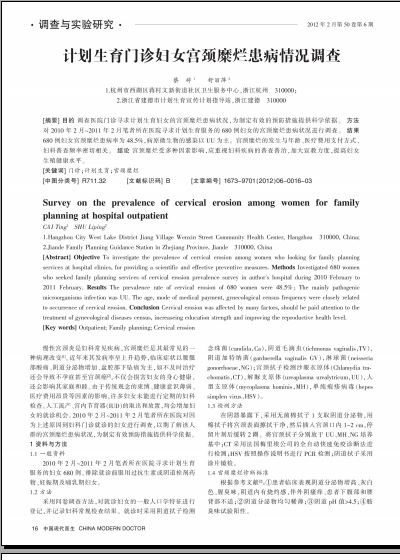计划生育门诊妇女宫颈糜烂患病情况调查(1)
 |
| 第1页 |
参见附件。
[摘要] 目的 调查医院门诊寻求计划生育妇女的宫颈糜烂患病状况,为制定有效的预防措施提供科学依据。 方法 对2010年2月~2011年2月笔者所在医院寻求计划生育服务的680例妇女的宫颈糜烂患病状况进行调查。 结果 680例妇女宫颈糜烂患病率为48.5%,病原微生物的感染以UU为主。宫颈糜烂的发生与年龄、医疗费用支付方式、妇科普查频率密切相关。 结论 宫颈糜烂受多种因素影响,应重视妇科疾病的普查普治,加大宣教力度,提高妇女生殖健康水平。
[关键词] 门诊;计划生育;宫颈糜烂
[中图分类号] R711.32 [文献标识码] B [文章编号] 1673-9701(2012)06-0016-03
Survey on the prevalence of cervical erosion among women for family planning at hospital outpatient
CAI Ting1 SHU Liping2
1.Hangzhou City West Lake District Jiang Village Wenxin Street Community Health Center, Hangzhou 310000, China; 2.Jiande Family Planning Guidance Station in Zhejiang Province, Jiande 310000, China
[Abstract] Objective To investigate the prevalence of cervical erosion among women who looking for family planning services at hospital clinics, for providing a scientific and effective preventive measures. Methods Investigated 680 women who seeked family planning services of cervical erosion prevalence survey in author's hospital during 2010 February to 2011 February. Results The prevalence rate of cervical erosion of 680 women were 48.5%; The mainly pathogenic microorganisms infection was UU. The age, mode of medical payment, gynecological census frequency were closely related to occurrence of cervical erosion. Conclusion Cervical erosion was affected by many factors, should be paid attention to the treatment of gynecological diseases census, increaseing education strength and improving the reproductive health level.
[Key words] Outpatient; Family planning; Cervical erosion
慢性宫颈炎是妇科常见疾病,宫颈糜烂是其最常见的一种病理改变[1]。近年来其发病率呈上升趋势,临床症状以腰骶部酸痛、阴道分泌物增加、盆腔部下坠痛为主,如不及时治疗还会导致不孕症甚至宫颈癌[2],不仅会损害妇女的身心健康,还会影响其家庭和睦。由于传统观念的束缚、健康意识薄弱、医疗费用昂贵等因素的影响,许多妇女未能进行定期的妇科检查。人工流产、宫内节育器(IUD)的取出和放置,均会增加妇女的就诊机会。2010年2月~2011年2月笔者所在医院对因为上述原因到妇科门诊就诊的妇女进行调查,以期了解该人群的宫颈糜烂患病状况,为制定有效预防措施提供科学依据。
1 资料与方法
1.1 一般资料
2010年2月~2011年2月笔者所在医院寻求计划生育服务的妇女680例。排除就诊前服用过抗生素或阴道栓剂药物、妊娠期及哺乳期妇女。
1.2 方法
采用问卷调查方法,对就诊妇女的一般人口学特征进行登记,并记录妇科常规检查结果。就诊时采用阴道拭子检测念珠菌(candida,Ca),阴道毛滴虫(tichmonas vaginalis,TV),阴道加特纳菌(gardnerella vaginalis GV),淋球菌(neisseria gonorrhoeae,NG);宫颈拭子检测沙眼衣原体(Chlamydia trachomatis,CT),解脲支原体(ureaplasma urealytricum ......
您现在查看是摘要介绍页,详见PDF附件(2740kb)。